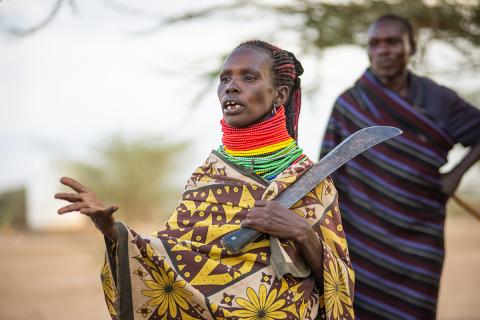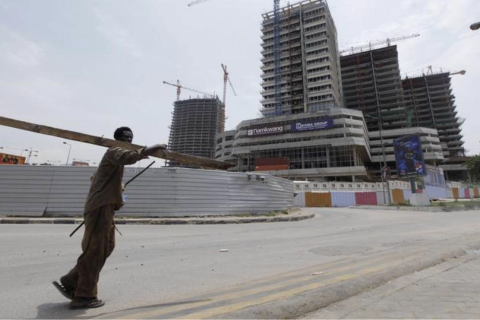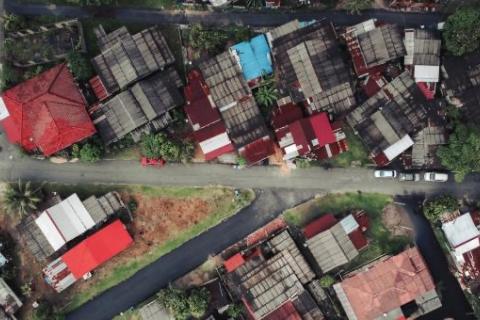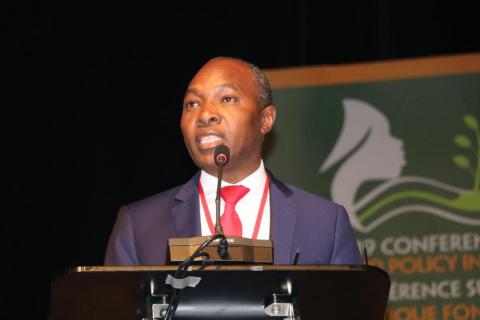Safeguarding tenure rights in land consolidation
I was assigned to lead the preparation of the assessments and amendments to the land consolidation legislation in 2016. That appeared to be a burdensome task. The first two land consolidation projects in North Macedonia were initiated according to the existing Land Consolidation Law and the implementation was blocked. The Law simply had no legal solutions for the identified field situations. The problems were many and each was ascending the other in its magnitude and sensitivity.
Empowering Women for Open Data Mapping in Agriculture: Implications for Land Rights and the SDGs in Africa
This blog recapitulates the interventions made by the panelists of a recently held GODAN Action webinar on “Empowering Women for Open Data Mapping in Agriculture: Implications for Land Rights and the SDGs in Africa”, Victor Sunday, Dr. Toyin Ojo, Nathalie Sidibe and Uchechi Shirley Anaduaka.
Facilitating a Coordinated Response
By Grace Goodrich
In the second part of an exclusive with Africa Oil & Power, United Nations Conference on Trade and Development’s Director for Africa, Paul Akiwumi, discusses trade facilitation reforms, debt relief programs and Official Development Assistance as instruments of aid for Angola during COVID-19.
What role will trade facilitation and policy reforms play in helping reduce Angola’s dependence on fuel exports?
Asia-Pacific Off Track: 20% of SDG Indicators Predicted to be Worse in 2030
By Catherine Benson Wahlén, Thematic Expert for Human Development, Human Settlements and Sustainable Development (US)
Sustainable Forests and Reaching the SDGs
Whether from the emergence of infectious diseases, the growing risks to global food systems, or from the increasing variability in global climate and local weather patterns, it is evident that we urgently need to rebalance our relationship with nature. Our relationship with forests is a prime example.
Forests are among the most biodiverse of Earth’s ecosystems. They sequester carbon and help to mitigate against climate change. They protect watersheds and help to control soil erosion. And yet, around 11% of carbon dioxide emissions come from deforestation and forest degradation, which is second only to the energy sector.
The 21st of March was the International Day of Forests, and it convened under the theme of forests and biodiversity. This is fitting in 2020, the beginning of a critical decade for the planet. There will be landmark moments early in the decade, including the anticipated adoption of a new post-2020 global biodiversity framework.
The United Nations Environment Programme World Conservation Monitoring Centre (UNEP-WCMC) is a Centre of global excellence in biodiversity. Over the past 10 years, we have been closely involved with REDD+, an initiative under the climate change convention (UNFCCC) that aims to support developing countries to reduce emissions from deforestation and forest degradation, and to promote the conservation, sustainable management and restoration of forests. Working closely with the UN-REDD Programme, we help countries to plan for and access results-based payments for these actions.
In work led by UNEP-WCMC, the UN-REDD Programme has supported over 20 developing countries to analyze where REDD+ actions could result in multiple benefits beyond carbon. Through spatial analyses carried out in close collaboration with national partners, countries have been empowered to identify areas that have potential for forest conservation, restoration and sustainable management, and can also help secure a range of additional important benefits for people and planet.
These analyses have shown how sustainable forest practices across the planet can contribute to a wide range of the Sustainable Development Goals.
One such example is Costa Rica. The National REDD+ Secretariat, together with FONAFIFO (the country’s National Forestry Financing Fund) and the UN-REDD Programme used spatial analyses to explore where REDD+ actions could help secure benefits beyond carbon, such as enhanced water regulation to support communities vulnerable to water stress, the potential for socio-economic improvements from forest-dependent livelihoods, and from ecotourism.
The work emphasized areas of overlap between the National REDD+ Strategy and spatial priorities for Costa Rica’s other objectives, such as national development, restoration and biodiversity conservation. Considering these benefits when planning and implementing REDD+ will help progress towards SDGs 1 (No Poverty); 6 (Clean Water and Sanitation); 13 (Climate Action); and 15 (Life on Land), among others.
More recently, this work also featured in the development of Costa Rica’s Gender Action Plan (contributing to SDG 5 on Gender Equality). Spatial layers showing the proportion of women by district contributed additional insight and helped to highlight districts where women could act as conservation agents, support efforts to reduce forest fires, and undertake reforestation activities.
Another example is Côte d’Ivoire, where we collaborated with the country’s REDD+ Permanent Executive Secretariat and the Swiss Scientific Research Centre to develop a forest restoration opportunities map. This combined potential benefits, such as carbon density, soil erosion risk and species richness, with obstacles to forest restoration, such as infrastructure development and high human land use. The resulting map shows areas with higher potential and lower obstacles, and thus where forest restoration could be most effective and have the most positive impacts. This could include contributing to SDGs such as SDG 6 (Clean Water and Sanitation), 13 (Climate Action), and 15 (Life on Land).
This type of analysis can identify where agroforestry actions are feasible to guide implementation of Côte d’Ivoire’s National REDD+ Strategy, promoting the use of agroforestry to strengthen agricultural systems’ resilience to climate change, and to diversify incomes for farmers. There is also an opportunity to align REDD+ and private sector cocoa initiatives, with the potential to create more incentives for smallholder farmers and contribute to SDG 12 (Responsible Consumption and Production), among others.
Meanwhile in Viet Nam, lessons from the National REDD+ Programme are informing the development of a deforestation-free jurisdiction in the Central Highlands. This region is at the forefront of efforts to conserve natural forests and other biodiversity, while sustaining production of high-value crops like coffee. Both nationally and locally, partners are seeking to promote sustainable land management and pilot a deforestation-free approach in the region in support of SDGs 13 (Climate Action) and 15 (Life on Land).
These individual examples give us just a snapshot of how retaining, restoring and sustainably managing our forests can help achieve a wide variety of SDGs and bring a range of benefits for people and for nature. As this year’s International Day of Forests slogan put it, our forests are too precious to lose.
More information is available here.
Ten land messages from ILDC2020 that India needs to listen to
About 350 land actors from government, academia, civil society and business came together from more than 15 states and outside India to discuss and debate various land issues. In more than 30 sessions, about 150 speakers and panelists deliberated over 3 days around interdisciplinary land-conversations to generate important information and evidence for policy, practice and academics.
Ten important land messages that emerge from these land conversations are:
ILDC-2020: A brief overview of proceedings
India-Land and Development Conference (ILDC) – 2020 held in New Delhi from March 2 to 4 saw a lively debate on a wide range of issues relating to India’s land sector. More than 100 academicians, young researchers, activists and policy makers made their presentations in the conference spread across 34 thematic and two plenary sessions. More than 350 delegates participated in the event.
Behind high-rise buildings and skyscrapers hides poverty and inequality in urban Angola
Will skyscrapers one day represent the prosperity that every Angolan citizen has dreamed about? Perhaps.
From the Middle East to North America, high-rise buildings and skyscrapers are cropping up as a symbol of wealth and prosperity in global cities. Modern Africa has experienced unprecedented urban growth and embraced zoning regulations and reforms that incentivize high-density growth and mixed-use buildings in major metropolitan areas.
During my recent trip to Luanda, the capital of Angola, the first thing that caught my attention was the city’s skyline.
Announcing PlaceFund
Today we are pleased to mark the official launch of PlaceFund, an independent US nonprofit organization focused on addressing issues of insecure property rights, unsustainable land use, and climate change. Built off a decade as the Property Rights initiative at Omidyar Network, PlaceFund will operate under the leadership of Peter Rabley and Amy Regas, who will be leaving Omidyar Network to run this venture, and they will take our shared commitment to property rights and geospatial technology into the new decade.
Leveraging Open Data in the Fight Against Corruption
The land sector is increasingly being cited as a corruption hub. Many countries across the globe are grappling with land-related corruption that dates to the colonial years and which have metamorphosed into historical injustices and continue to be a source of conflict and violation of basic human rights. Cases of land grabbing, compensation-less expropriation, gender-based discrimination in accessing and ownership of land and related resources, illegal mining deals, bribing to access land administration services among others are not new in the lands sector.
Keynote Address by Stephen Karingi, Director, Regional Integration, Infrastructure and Trade Division, UN Economic Commission for Africa
It is my privilege to address you, on behalf of the Executive Secretary of the United Nations Economic Commission for Africa, Dr. Vera Songwe, and welcome you to the 3rd Conference on Land Policy in Africa.
I would like to extend our gratitude to the Republic of Cote D’Ivoire and the African Development Bank for hosting the third Conference on Land Policy in Africa. As the host institution of the second land conference, we recognize the tremendous effort that goes into hosting this conference.











